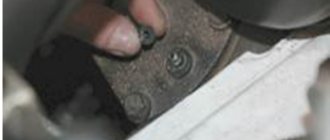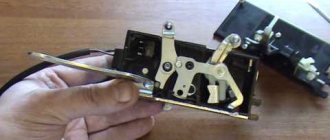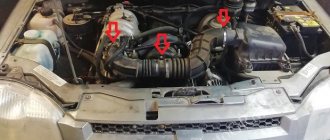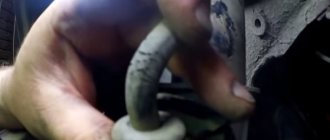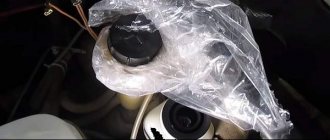Using a syringe with a tube, completely pump out the fluid from the power steering reservoir.
Niva Chevrolet Niva Chevrolet replacing the heater hose using the dentist's method
If the power steering fails, it is possible to drive the car, but the steering wheel will be difficult to turn and will become heavy. To partially replace the power steering oil, you will need a syringe with a tube and the oil itself, enough so that at the end of the work it will no longer be dark.
[em]Continuation of the report (+) - Alexander - What is the frequency of changing the power steering oil? I thought about just disconnecting the hose...
At this moment, you must not allow the power steering oil to completely drain from the reservoir into the system and allow air to be sucked in! You can drain everything old so that it doesn’t mix with the new when topping up.
To partially replace the power steering oil, you will need a syringe with a tube and the oil itself, enough so that at the end of the work it will no longer be dark. The fitting is located to the right of the gearbox axis in the top cover and is secured with 4 bolts in the center - adjusting the gearbox backlash; internal hexagon; replacing power steering hoses on a Chevrolet Niva; lock nut. Drive onto an overpass, or jack up the car so as to hang the front wheels of the Chevrolet Niva, in order to be able to easily rotate them with the engine not running.
The oil itself is not aggressive to your hands or paintwork, like brake fluid, for example? The screw is located on the gearbox cover, which is secured with four bolts. Am I now studying the picture in the manual?
You can drain everything old so that it doesn’t mix with the new when topping up.
Next, assemble the line, pour new water into the reservoir, one swings the steering wheel between the extreme positions without starting the engine, the other unscrews the fitting with a key of 8, as on the brake fittings, the cone-to-cone fit is the same and bleeds the air. In the process, add oil to the reservoir. When liquid flows through the fitting, close it.
Start the engine, one rotates the steering wheel as stated above, the other, in extreme positions, bleeds air through the fitting, CAUTION, as there is a possibility of getting a jet in the face, there is pressure on a running engine. As soon as one fluid flows, consider the process complete, tighten the fitting well. This sequence of actions was carried out personally on the advice of a person from the Elex warranty station; I did not find an accessible manual anywhere.
After replacing the steering wheel became even lighter, 1 click the flight was normal. After replacing, wash your face and hands; no traces or irritation were noticed. The fitting is located to the right of the gearbox axis in the top cover and is secured with 4 bolts; in the center there is an internal hexagon and a lock nut for adjusting the gearbox play.
During operation, Chevrolet Niva power steering fluid can leak in various places, most often through hoses. As a result, the power steering oil level will drop.
Driving without fluid in the Chevrolet Niva's power steering puts you at risk of breaking the power steering pump, which costs a lot of money, since it will run dry. As a result, it will suffer serious damage and fail.
Story
I have already said many times that I do not do tuning or modifications for the sake of the process. Only if there are problems. In this case, it all started with the “collective farmers” of AvtoVAZ. For a very long time, the plant installed German ZF power steering pumps on the assembly line, and then suddenly the Russian version came into use. As usual, the plant was not going to give any explanations, so I had to turn to another source, the manufacturer ZF. A technical seminar organized by this company was held in St. Petersburg, and I asked the German a question about this situation. Directly at the lecture (that is, the official position), the German specialist said that this is a trade secret. And during the lunch break, when I addressed him in German, he straightened up and said the following. Quote. Along with the supply of pumps, we gave a recommendation to AvtoVAZ on what SHOULD be poured into the system. At first, the plant filled it with an approximate analogue of the liquid that we recommended, and then suddenly it started pouring green Pentosin. The result was not long in coming - leaks and a humming sound when turning. But the funny thing is that all these “supposedly” warranty cases were transferred to the shoulders of ZF. The German said that we “butted heads” with the plant a little, did not get clear answers from the managers and management and simply stopped supplying this spare part. End of quote. Now we come to a simple conclusion: in order to get a working unit, as intended by the designers, we need to flush the system and fill it with what is recommended. The fluid is simple, good synthetic dextron, but along with it I recommend replacing the low pressure hoses.
Power steering device.
This part makes it easier to control the wheels by helping to turn the steering wheel. It would seem that this is already a fairly simple task that does not require any assistants. But it’s worth driving a car with and without power steering to understand how important this component is. This is especially noticeable on large and heavy cars, like the Chevrolet Niva.
- pump
- fluid refill tank
- valve system
- hydraulic rack.
What are all these components intended for and how to understand if they break down which of them requires replacement. To do this, it is necessary to dwell on each of them in more detail.
Pump. This is a key component of this system. Driven by a car engine using a belt drive. It is filled with oil, which is supplied under pressure twice as high as atmospheric pressure.
Power steering reservoir. Usually made of high strength plastic. Filled with synthetic oil for power steering operation. The fluid level must be checked periodically to prevent leaks.
Rotary valve. When the steering wheel is rotated, the necessary valves open in the direction of gain. If the wheels are installed straight, the valve closes and there is no impact.
Hydraulic fluid in a Chevrolet Niva is oil that transmits resistance from the pump to the hydraulic cylinder. This mechanism makes it easier to turn the steering wheel. In addition, the product lubricates car parts and prevents them from wearing out.
Oil circulation through the power steering system occurs through connecting units and hoses. The mixture level is indicated on the expansion tank with MIN and MAX marks. So every motorist should monitor the amount of oil and add it in a timely manner. Otherwise, the system will fail, and its repair will be expensive.
Driving a vehicle without hydraulic fluid will damage the pump, which is an expensive part. As a result, the power steering mechanism will not be able to work. If the Chevrolet Aveo is left without oil in the power steering system, you need to call a tow truck.
If the power steering fails, it is possible to drive the car, but the steering wheel will be difficult to turn.
Driving without hydraulic booster mixture puts you at risk of breaking the pump, which costs a lot of money, as it will run dry. As a result, the part fails prematurely.
Like any other fluid, hydraulic oil loses its properties over time. According to the regulations, replacement is required every 100 thousand km or once every 2-3 years. In addition, the power steering system may fail for other reasons, in which case new oil is added.
Signs that the power steering fluid needs to be replaced:
- Feeling of reverse shocks on the steering wheel. If the pump drive belt is tense or worn, it must be replaced, and then the power steering solution must be changed;
- The steering wheel turns with great effort or, on the contrary, too easily;
- The mixture in the tank has lost its original color;
- Feeling a burning smell;
- Low level of solution in the system;
- Low engine idle speed;
- Dirty tank filter;
- Low operating pressure of the power steering pump;
- Availability of air in power steering.
Frequent use of a Chevrolet Niva car leads to a change in the color of the solution. This is the main reason for changing the power steering oil. You should also not leave the car with the steering wheel turned all the way in the parking lot, as this leads to premature wear of the parts.
The driver must promptly check the power steering system, as well as:
- control the oil level, its color and quality;
- check the tension of the drive belts on the power steering pump;
- check hoses for leaks.
Power steering is not installed on all Niva cars as standard, so almost all Niva drivers strive to improve their car with the help of this useful unit. You can buy both the German and Russian versions, which are best installed in a workshop if you do not have significant experience in auto repair to do it yourself. The cost of parts is about 25-27 thousand rubles; for work at a service station they can charge about 8-10 thousand rubles.
The general scheme for installing power steering on a domestic Niva is as follows:
- Remove the negative terminal from the battery (key set to “10”).
- Remove the mounting bracket from the spare wheel and the wheel itself.
- Disconnect the tubes/wires from the washer motors and remove the washer reservoir.
- For injection options, remove the fuel filter from the left mudguard without disconnecting the fuel supply hoses (with a socket wrench set to “10”).
- Using a Phillips screwdriver, remove the lower and upper steering shaft housings.
- Remove the harness blocks from the wires from the three-sacrum switch, ignition, emergency lights, and brake signal.
- Using socket wrenches and wrenches set to “13”, unscrew the bolt that secures the end of the intermediate driveshaft.
- Using a chisel, hammer, socket wrench “13”, free the Niva from the shaft bracket (steering wheel), steering wheel and intermediate driveshaft.
- Using a wrench and a socket wrench set to “13”, unscrew the bolt securing the upper end of the propeller shaft and remove the latter.
- Remove the rod from the vacuum brake booster by removing the mounting bracket (done with pliers and a flat-head screwdriver).
Also interesting: Chevrolet Niva transmission repair in St. Petersburg (St. Petersburg), Primorsky district, list of car services - addresses, phone numbers and reviews
How the part is located on the car
To install power steering, you need to make some changes to the engine. To do this, a mounting bracket from the power steering pump is installed on the cylinder block, the marking of the center of the side hole is determined, and a threaded hole with a depth of strictly 12 mm is made. Then the nut securing the pulley on the crankshaft is unscrewed (with 4th gear engaged and the hand brake on).
In almost all modern cars, hydraulic power steering is an integral part. A car without power steering can easily be considered an obsolete vehicle, because its presence greatly simplifies the control of the car’s wheelbase. Driving becomes simple and easy. This is especially true for the Chevrolet Niva, since it belongs to the class of SUVs, where it is very important to ensure good handling.
https://www.youtube.com/watch?v=mTyrpAgAJtk
But what should you do if some problems arise with the power steering while driving? It is necessary to immediately carry out self-diagnosis or contact a car service. It is highly not recommended to continue driving, since problems with this element can lead to the steering wheel jamming and an emergency situation on the road.
But the cost of the device itself and the work to replace it is quite high. Therefore, before you give the car to specialists, you need to be sure that the problem is in the power steering, and also try to repair it yourself. This will require knowledge of the device and specific types of faults.
Briefly about the features of installing power steering on the Niva:
- First, the central nut of the steering wheel is unscrewed, after which it is dismantled. A puller may be required to remove the nut. The universal joint is also removed from the steering wheel.
- Then the fan strap is loosened.
- After installing the hydraulic booster, you need to fill the system - to do this, unscrew the expansion tank cap and fill the system with oil to the required level. After this, the steering wheel should be turned to its extreme positions several times with the engine turned off, this will get rid of the air lock in the system.
- When bleeding the system, it is recommended to jack up the front of the car or disconnect the steering rod from the bipod. Next, the engine is started and the required amount of liquid is added to the system. If you notice that after adding the oil it begins to foam, this indicates that air has entered the power steering hoses. Then you will need to turn off the engine and wait a while until the bubbles stop coming out.
- The procedure is carried out almost identically to installing the EUR, only there are some nuances. Before you begin the process, carefully read the service book that comes with the kit (the author of the video is the Andrew Humm channel).
Hoses for power steering Niva Chevrolet, life
set of 3 hoses
The power steering system consists of 4 hoses. One high pressure with a valve in the middle (pump-steering machine) and 3 low pressure hoses. In the designer's fields, the radiator was completely excluded from the system, so there are only two low-pressure hoses. The pressure in the “main” hose reaches several tens of kg, but there is almost no pressure in the “secondary” hoses. The plant, with the tenacity of maniacs, installs rough, thick-walled high-pressure hoses. Their disadvantage is that they cannot normally be compressed even with threaded clamps, especially in cold conditions. So their wet appearance is normal. The recommendation is simple, along with replacing the fluid and flushing the system - replace the Chevrolet Niva power steering hoses with modern and high-quality ones. Since I don’t really like stepping on rakes, I consulted with a hydraulic engineer on this topic. He “gave me” a Taiwanese hose manufacturer. The working pressure of the hoses is 250PSI (approximately 17 atmospheres). For general technical development, let me remind you that PSI is pounds per square inch. The hoses are two-layer. The internal part is MBS (oil and petrol resistant), the external part maintains external temperatures. Based on many years of installation experience on different machines, I can say the following. No cracks have ever been noticed in any climate. The most I have noticed is fading after a couple of years of use in hot climates, but as you know, this does not affect the speed. I added a couple of centimeters to the length of the hoses so that they would not rub against the air filter housing, as often happens in the factory version. For the Niva, the price list will include an option of two hoses.
Main elements of the system
The design of the VAZ-2123 provides refueling tanks that ensure smooth functioning of the mechanisms.
The main elements of the system include the following filling containers:
- fuel tank;
- transmission housing;
- power steering;
- cooling system;
- engine lubrication system;
- axle and transfer case housings;
- container for hydraulic drive of the brake system;
- tanks for washer fluid;
- containers for refilling the air conditioner.
The following is a table of fuel volumes for the Chevrolet Niva:
To improve the performance characteristics of an SUV, working fluids must be poured in quantities recommended by the developers of the Chevrolet Niva.
Fuel tank
All-wheel drive and increased cross-country ability of the Chevrolet Niva increase fuel consumption. Therefore, this AvtoVAZ model has a 58-liter fuel tank. It is located in the rear of the car. The fuel tank is made of high-strength steel and has a complex design.
Because gasoline tends to evaporate, excess pressure can build up inside the gas tank, increasing the risk of explosion. To reduce pressure, the designers of the VAZ-2123 provided an adsorber valve, with the help of which excess gasoline vapors are released.
The fuel tank housing has a stamping for the driveshaft channel, which divides the gas tank into two communicating reservoirs. Therefore, about 7 liters of fuel remains in the tank, which does not enter the fuel line. However, the design of the gas tank allows fuel to be filled under the neck, which allows you to fill up to 64 liters of fuel. This feature compensates for the unconsumable remaining gasoline.
Cooling system
When the car engine is running, the temperature of the exhaust gases reaches 2000 degrees. Due to the elevated temperature, the lubricant burns out. This leads to engine malfunctions and wear of parts. To avoid engine overheating, VAZ-2123 vehicles are equipped with a closed-type liquid cooling system, which consists of the following components:
- radiator;
- expansion tank;
- fan;
- water pump.
For cooling, antifreeze is used with the addition of additives that have anti-corrosion properties. The operating principle of the cooling system is based on the forced circulation of antifreeze through the cooling jacket around the engine cylinders.
The pump ensures uniform circulation of the coolant. After starting the engine, the pump begins to pump antifreeze through the small circuit of the cooling system. When the engine heats up, the thermostat activates, after which a large circuit opens. The expansion tank is needed to relieve excess pressure that occurs when the antifreeze heats up. Passing through the radiator, the liquid is cooled by a fan.
Engine lubrication system
Friction and high temperatures reduce the service life of the engine and the service life of the vehicle. To avoid premature wear of engine parts, it is necessary to monitor the oil level. In the Chevrolet Niva, the designers have developed a combined engine lubrication system. The crankshaft and camshaft bearings, pushrod tips and rocker arm bushings are pressure lubricated. The remaining parts are lubricated using the spray method.
Using an oil pump, oil from the crankcase through the oil receiver enters the filter housing. After cleaning, the lubricant is supplied to the oil line, from where it is supplied to the parts under pressure through inclined channels. The pressure at medium speeds in a working VAZ-2123 lubrication system is from 200 to 400 kPa. A decrease or increase in pressure indicates a system malfunction.
What tools for preparation
Special tools do not require changing the oil in the power amplifier. One key number 10. Fixed screwdriver. And a container for liquid that will drain. Due to the tightness of the engine compartment, it is best to take a cut plastic bottle. Well, the process itself First, release the clamping cup clamp from the key.
Wipe it gently with a cloth. It is necessary that dirt accidentally gets into the tank. Only then carefully unscrew the tank cap using the level indicator. Carefully pour the liquid into the bowl. Using a screwdriver, loosen the hose clamp from the power steering to the tank. This is a drain hose. Hole in tank, connection to remote hose, plug. The hose itself is directed into a container to drain the liquid.
